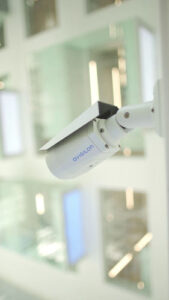Advancements in video technology and processing capabilities allow a more flexible approach to creating smart video security solutions. These smart solutions offer a host of intelligent features which increase efficiencies and help deliver enhanced security and safety.
Modern video solutions have incorporated the recent advances in processing capabilities to automate tasks based on rules and complex algorithms to simplify the management of security and response workflows. One area which has grown significantly is the use of AI-driven video analytics. Whether the technology is used to detect potential incidents, trigger alarms, speed forensic investigations of critical events for evidence collection or to evaluate trends over time, Avigilon’s latest fixed video security system, including its flagship H5A camera platform, can help enhance detection and reduce response time to safeguard facilities and their people.
The Avigilon H5A camera platform makes use of neural network-based intelligence, also known as artificial intelligence, on board the cameras to improve detection, classification and tracking of objects in its field of view to increase situational awareness. Through a combination of self-learning video analytics, deep-learning algorithms and SmartCodec technologies for more efficient video streams, this next generation camera platform can supplement security with advanced analytic technologies, such as the detection of unusual activity in a scene, facial recognition and even a collection of analytic tools that aid in pandemic response efforts including monitoring for people not wearing face masks or not properly social distancing.
In application, take a manufacturing plant, for example. Operators of the plant could deploy Avigilon H5A cameras at entrance and exit points of a facility. Using object classification, the cameras would capture footage of all vehicles entering and leaving the site. These would automatically be classified by vehicle type, such as car, bus, lorry, bicycle, etc..
Such sites are likely to have systems with high camera counts, all capturing footage in real-time. This presents a challenge to operators if an incident occurs. With numerous real-time streams from across a site, or even multiple remote sites, finding relevant footage can be a resource-intensive exercise. Traditional video surveillance systems require an operator to have an idea of where and when an incident occurred. They then must manually ‘scrub’ through hours of recorded video, looking for relevant footage. This is both time consuming and potentially inaccurate.
 Using AI-driven analytics on board Avigilon’s H5A cameras, operators can use Avigilon Control Center, a video management software which includes an AI-powered video search engine called Appearance Search technology to simply search for objects by classification type. If, for example, it is necessary to find a car which has entered a loading area, they can filter activity by vehicle type and even colour. This will automatically filter out any lorries, buses, motorcycles, bicycles or pedestrians. The filtering is fast and accurate, allowing searches which typically take hours to locate a short evidentiary clip to mere seconds.
Using AI-driven analytics on board Avigilon’s H5A cameras, operators can use Avigilon Control Center, a video management software which includes an AI-powered video search engine called Appearance Search technology to simply search for objects by classification type. If, for example, it is necessary to find a car which has entered a loading area, they can filter activity by vehicle type and even colour. This will automatically filter out any lorries, buses, motorcycles, bicycles or pedestrians. The filtering is fast and accurate, allowing searches which typically take hours to locate a short evidentiary clip to mere seconds.
Once the vehicle of interest is identified, the operator can then further refine the search to easily find other instances where the vehicle was caught on that particular camera, or even across multiple cameras at other connected sites.
This powerful and efficient search capability allows an operator to quickly find footage which provides more information, such as where and when the car entered the site, when it left (if it has exited) or where it is if it’s still on site. It is also possible to extend the search to different days and locations.
The same process can be carried out with people, using a combination of information on gender, hair colour, clothing colour and age category (adult or child). The process allows an operator to search through hours of footage and identify several appearances of an individual in seconds.
The power of the H5A camera platform means objects can be detected, classified and tracked in busy scenes, whether indoor or outdoor, and even when stationary. This can be critical, as most analytics systems only classify objects which are in motion.
Another powerful feature supported by the H5A camera platform that can help operators to proactively detect and respond to potentially critical events is Unusual Activity Detection (UAD). UAD is an edge-based feature which uses AI technology to learn what normal activity looks like in a scene, and leveraging the camera’s ability to classify humans or vehicles, can detect anomalous behaviour. Examples of this might be a person spotted in dangerous or prohibited areas like on top of a roof or in a potentially unsafe part of a factory. Another example might be a vehicle travelling at high speed in a parking lot. Because the camera has autonomously learned over time that such incidents are rare, it can automatically flag such unusual events to the operator when they do occur. When these exceptions are detected, they are highlighted and surfaced to operators, so they can investigate further into the matter.
By combining advanced analytics and AI-enabled technologies, the H5A camera platform can deliver benefits for a wide range of applications while also enhancing security and safety. Available in dome, bullet and box form factors, these high-performance devices elevate a video deployment from a static surveillance appliance to a security intelligence system.

